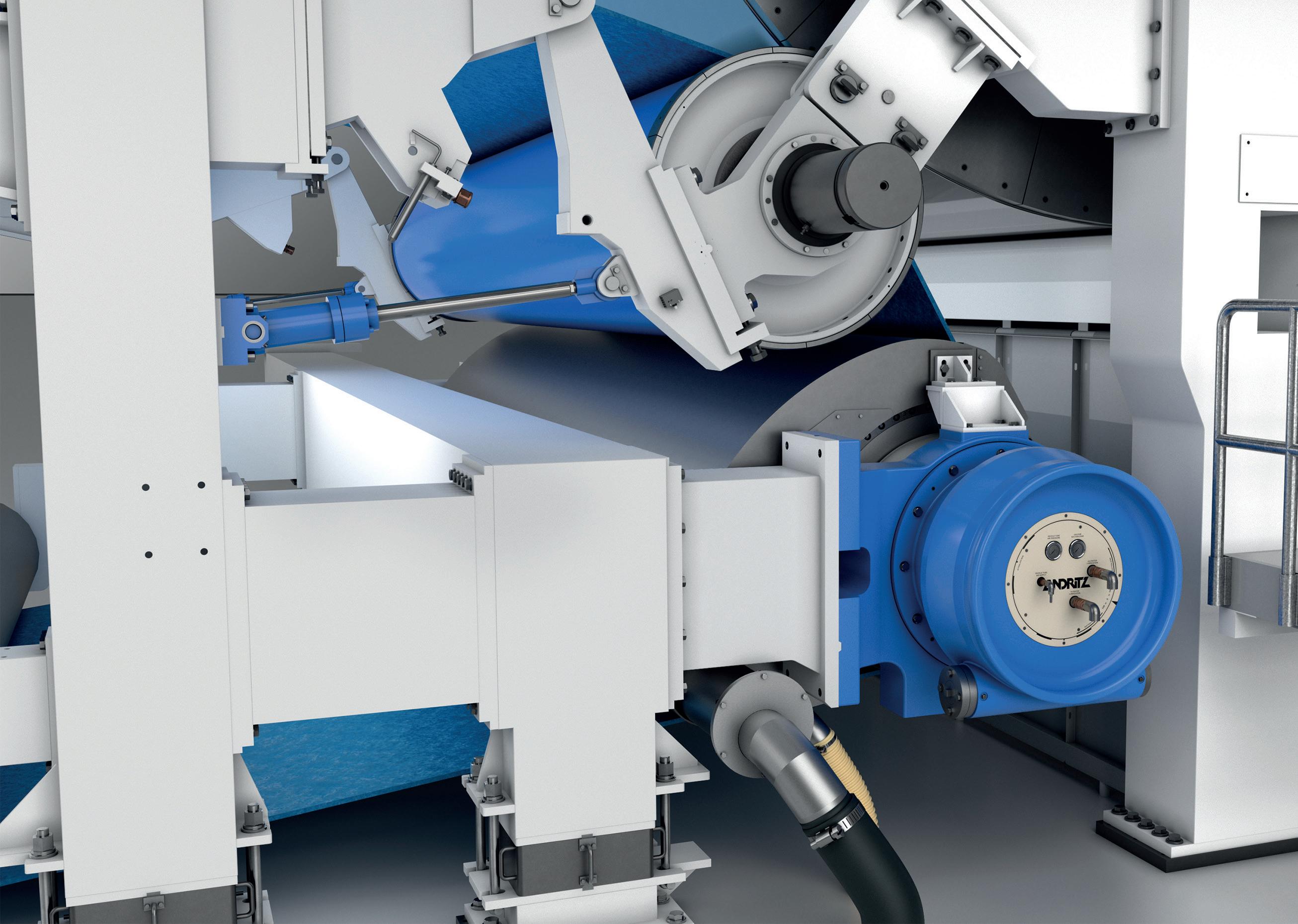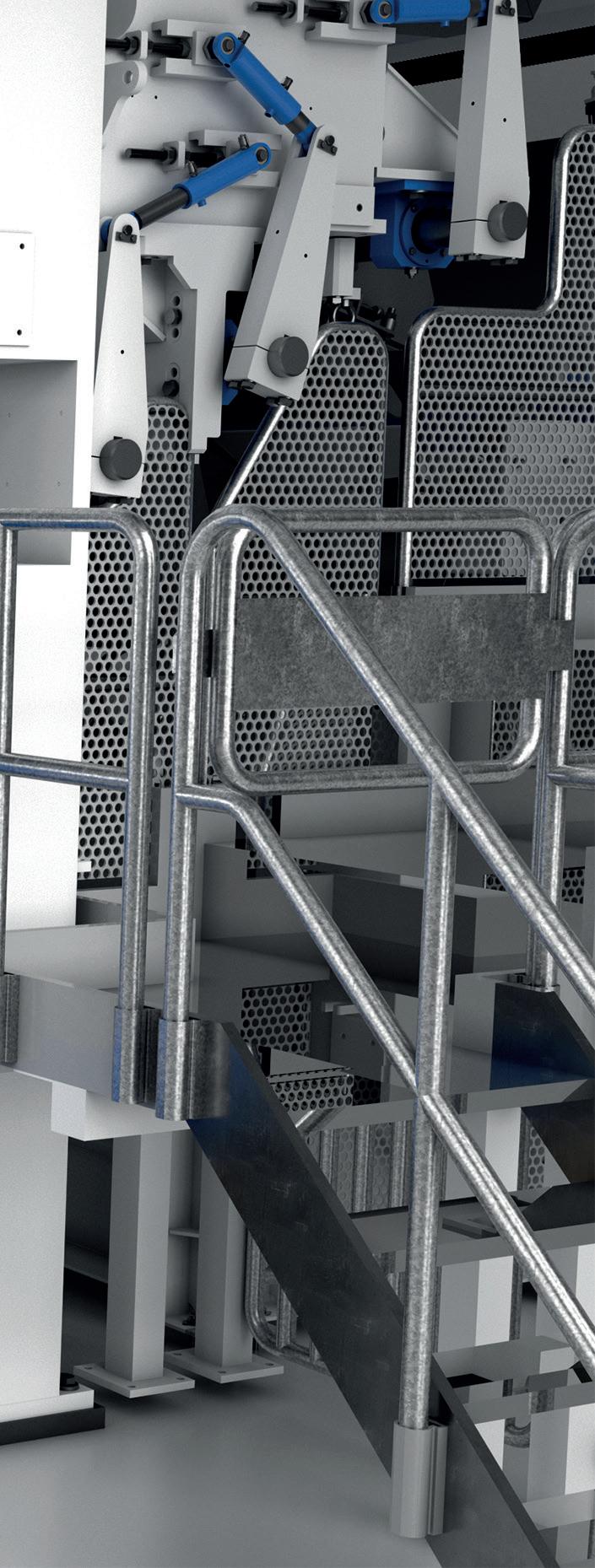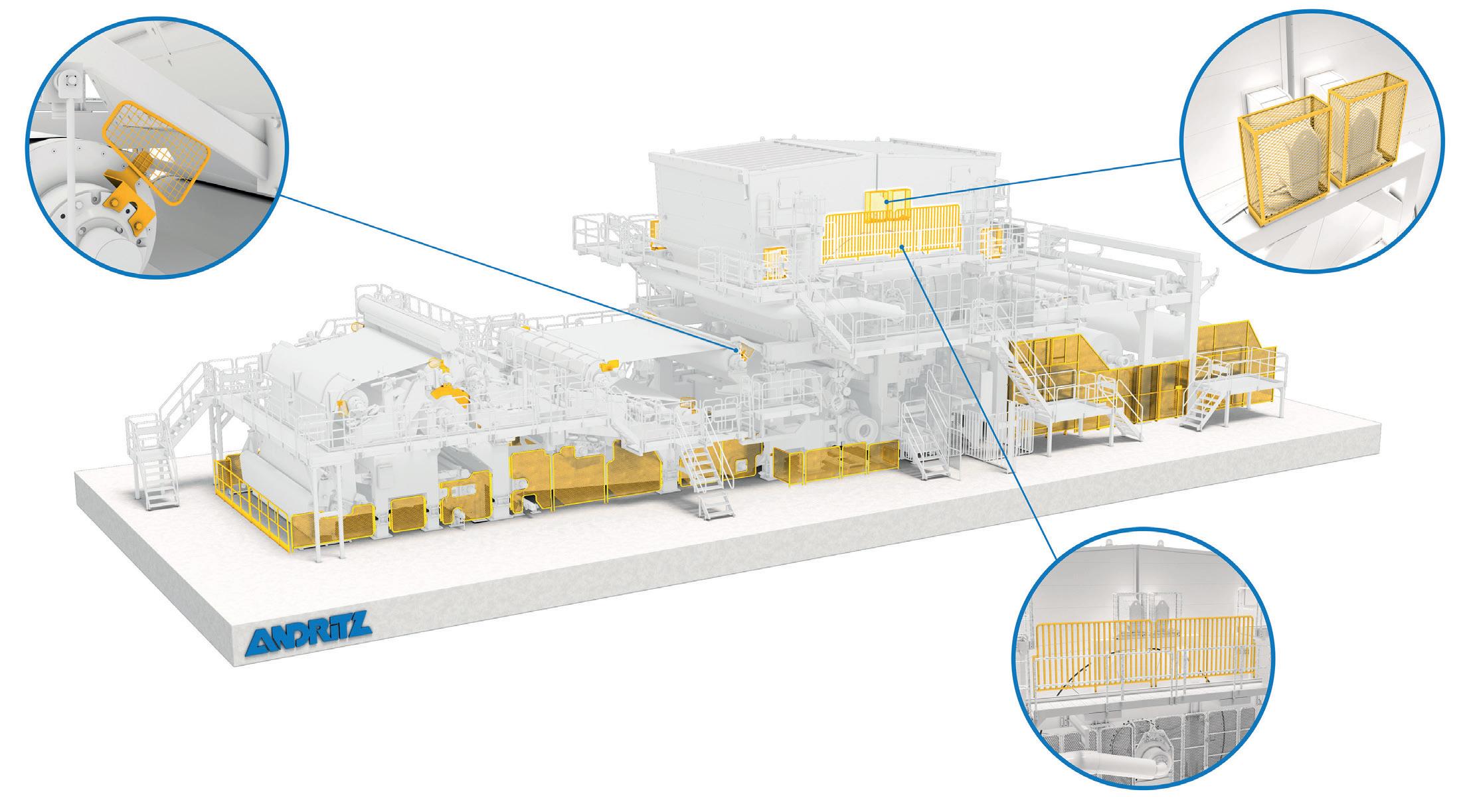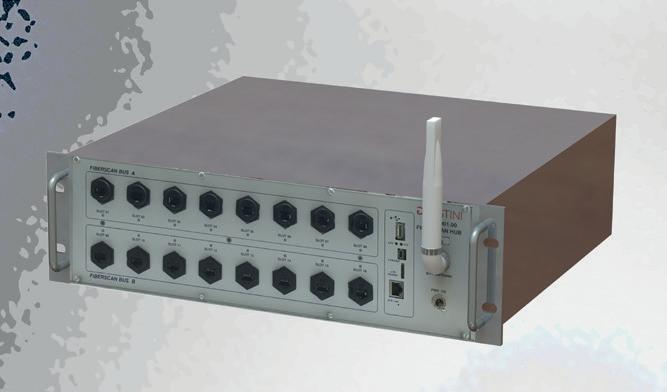
6 minute read
Tissue production – make it safe!
Avoiding accidents and unplanned downtime by using the highest safety standards is one of the foundations of producing tissue at high speeds today. The industry’s safety measures and concepts already go hand-in-hand with the continuing increases of machine performance and capacities. Nevertheless, this part of the tissue production process is subject to great dynamics, as not only technologies evolve, but also awareness of the importance of safety increases and the regulatory framework changes. In addition, the understanding and interpreting of the guidelines often varies by country and by supplier.
“Safety is quite a complex area for us as machine suppliers,” says Thomas Nager, machine safety expert at Andritz. “On the one hand we want to supply the safest tissue machines on the market, however on the other hand we also want them to be the most productive machines when it comes to ease of operation. We try to live a culture that combines these two, often remarkably divergent, topics.”
Advertisement
Andritz has gone to great lengths both to comply with machine safety regulations, and to go beyond them to ensure that every customer enjoys the highest level of safety in every machine the company supplies. Andritz follows three main principles when it comes to tissue machine safety: l A safe machine ensures the safety of the operating personnel and the surrounding environment l A safe machine is the basis for a reliable process to create maximum output l A safe machine is obligatory to fulfill legal requirements.
“The first and most fundamental of our principles when supplying tissue technology is that obviously we don’t want any operators to be hurt,” continues Nager.
“The second is reliability and machine performance, and third on the list is regulations and legal requirements.”
“Currently, European safety standards are the most detailed for tissue making and finishing machines. The basis for Andritz machines is the risk assessment in combination with the standards. For the European market, additionally, the Machine Directive, as well as the Electromagnetic Compatibility Directive (EMC), Low Voltage Directive (LVD) and Pressure Equipment Directive (PED) and their harmonised standards must be fulfilled. Products in compliance with these directives are identified by the CE mark (Conformité Européenne) which signifies that the products sold have been assessed to meet the legal requirements for health and safety.”
Andritz already communicates with the customer in the sales phase about the implications of the risk assessment and the most advantageous route to take.

Nager explains: “There are always discussions early on about the CE mark for the European market, and whether, for instance, the whole plant must have a CE mark, or individual machines only. As an example, a tissue machine needs a CE mark of its own, as does a pressure vessel such as a Yankee. Andritz ’s advice is to have individual CE marks, as updating in the future tends to be easier and more flexible than with a mark covering the whole plant, even if it is not necessary according to the machine directive.”.
In addition to CE markings on newly-supplied machines, Andritz provides audits on older machines to ensure that they comply with the current regulations. Furthermore, safety advice will be issued if it comes to major rebuild projects.
Other countries and regions also have their own conformity markings including the USA and Canada (e.g. UL for electrical components), China (e.g. CCC) and Russia and Eurasia (e.g. EAC).
“Of course all additional requirements in any given country or region will be respected and taken into account when delivering Andritz tissue machines,” adds Nager.
Under the European Machine Directive, which is the legal basis for machine safety in Europe, every machine that is placed on the market must have a risk assessment which is the core tool to ensure that safety has been seriously taken into account. This means identifying where any hazard areas may occur and taking defined steps to make those areas safe.
“This is not simply a case of ticking boxes,” says Nager. “This really is about reducing risks in the work environment, often in tight spaces. For example, it is quite common in the tissue industry for space to be a problem, and squeezing a machine into a tight area. If this happens, it is particularly challenging that people are kept at a safe distance away from the hazardous areas.
“We are working closely with our customers to improve the safety of their tissue production process, for example: Which safety elements need to be eliminated or by-passed; which kind of smart solutions can we offer or develop conjointly to create a safe environment?”
The ABC of safety on Andritz tissue machines
The risk assessment ensures that nothing is left out or forgotten when it comes to all aspects of safety on tissue machines. Andritz realizes this with its high competence in various fields, fully understanding the mechanical demands and with all process know-how in house. This involves making a list of all important factors relating to risk on a tissue machine and defining measures how to mitigate these risks.
“These standards are split into A-, B-, and C-standards” explains Nager. “A-standards are general safety related standards, such as ISO 12100 which defines what a risk assessment must contain; B-standards are more precise, related to different types of risk and C-standards which break the safety topic down to individual components such as tissue making equipment.
“This is complex and difficult to do. However this long list ensures that every area is covered, and no part of the machine or process is left out or forgotten.”
But essentially making tissue machines safe is not all about lists and standards. Ultimately, the aim is to identify any risk area and make it as safe as possible while at the same time allowing full and maximum efficiency of production to take place. This is where Andritz expertise comes into its own.

Getting down to basics
There are three areas Andritz concentrates on to ensure all parameters are covered when it comes to machine safety and maximum usability: l An inherently safe design –‘safety by design’ l Guards and fences where interaction is not necessary during operation l Functional safety where interaction is necessary during operation
Nager says: “The basic approach to making tissue machines safe is that, first of all, we try to avoid a hazard location altogether, for example by avoiding the interaction between human and machine. This is making the machine inherently safe.
“However, we all know that tissue production is a labourintensive activity and it’s not possible to avoid hazardous areas completely. This means that dangerous areas such as roll nips must have nip guards, and other areas need a fence to avoid operators getting too close. We have also carried out a lot of work on the design of machines at Andritz where the operator is able to avoid a hazardous area altogether by being able to carry out a task without entering a hazardous zone, for example by being able to pull out a lubrication point on the machine.”
The third area is the important one of functional safety where interaction is necessary during operation, which is quite common when operators need to check the quality of the tissue being produced.

Nager says: “The reel section is where operators always like to go in and touch and feel the quality of the paper being produced. In this case, Andritz has designed certain movements and interlocks within the machine where it is possible to enter the reel section at given intervals and perform tasks safely. Another example to point out is our fully-cantilevered shoe press concept, which allows for faster felt and shoe press belt changes while greatly increasing the safety of this process.”
“It must be noted that functional safety, although an important asset, is costly at the outset and has to be maintained on a regular basis.”
The subject of safety while carrying out cleaning and maintenance tasks is also an important factor, particularly in tissue making.
“Both cleaning and maintenance are very relevant areas when it comes to safety of operation,” says Nager. “Tissue production requires a high level of cleaning. We have focused our efforts in making sure that not only areas of the machine are more accessible for cleaning and maintenance, but we also have specially-designed CE-marked lifting equipment to avoid any accidents or injuries during maintenance such as roll changes.”
Future challenges
Safety and attitudes toward safety have come a long way in recent decades. However, there is still work to be done when it comes to regional approaches to safety.
“Improvements in safety have increased over the last 25 years. ‘Common sense’ used to be an integral part of the safety concept,” says Nager. “Now safety relies much more on the machine to keep people safe, in a way to take out the human element, and safety engineers are working more and more to prevent operators from manipulating the safety measures put in place, for instance disabling guards to make the job easier.”
One important factor Andritz is working on as a global company is the fact that in different regions there is a different approach to safety. Nevertheless, Andritz is always providing the very best safety solution for the respective market with additional features to choose from.
More information by email at tissue@andritz.com
Stop collecting paper samples! SmartScan™ measures paper dryness 24/7, safely .



Improve your press section efficiency! SmartScan™ contactless sensor accurately measures paper web dryness after the press section 24 hours a day, 7 days a week. Using a proprietary microwave technology, it is developed to overcome the typical limits of the NIR (near-infrared) sensors. SmartScan™ is available both for fixed point positions or traversing web scan. To save hundred of thousands of Euros in energy costs, stop collecting samples, choose the safe accuracy of SmartScan™ technology.










